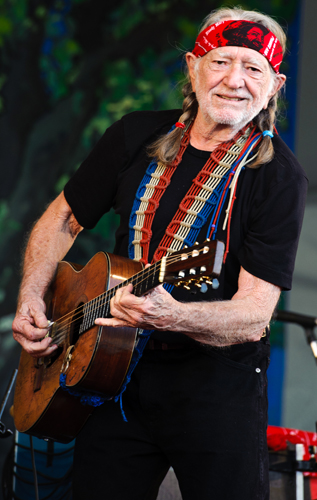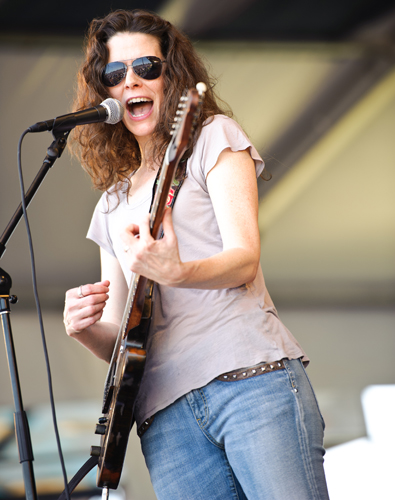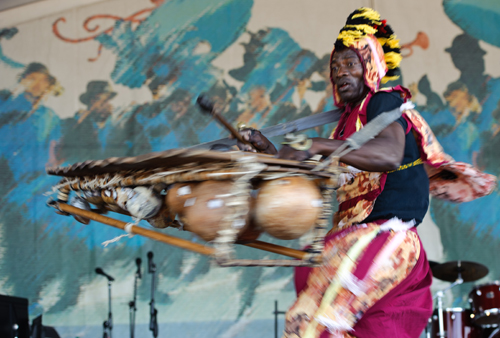Part of the joy of Jazz Fest is being blown away by someone unexpected. I had that twice yesterday:
– Yvette Landry‘s set in the Lagniappe Tent was a beautiful surprise, and not just because she had a drink holder on her mic stand (why doesn’t everybody?). She played a set of classic honky tonk – no more, no less – but it was beautifully executed. She writes in the mode with wit and intelligence, and she has the voice to inhabit the songs’ emotional range. Richard Comeaux’s pedal steel was a tasteful jolt of electricity every time he took a solo, and the drummer whose name I didn’t catch, patiently, calmly kept the band swinging. Every year at SXSW I see three or four bands that are trying too hard and fail to do what Landry makes sound effortless.
– One of the weirdest dance parties of Jazz Fest came when Roddie Romero and the Hub City All-Stars played “Walking to New Orleans.” Suddenly, people all around me developed odd, walking dances. A guy at the Fais Do-Do Stage to change the recycling container stopped, stood on orange plywood and did a stylized, rhythmic walk on the narrow boards while a trio of guys took long, stomping steps in time, plodding through the crowd. The moment was a reminder of how good the band can be, but way every song stretched out over five minutes with multiple solos suggests one possible reason why the only time we hear from them each year is Jazz Fest.
– Jamey Johnson’s album The Guitar Song ought to be titled The Steel Guitar Song because his player killed. And how many days of Jazz Fest can you remember hearing one – much less two – great pedal steel players? He brought out the Blind Boys of Alabama to end the set with “I Saw the Light,” and it went so well that Willie Nelson brought them out during his set to do it again.
– Kevin Thompson and the Sensational Six in the Gospel Tent brought to mind a thorny issue that I have yet to sort out. The tent was packed and rocking through the ecstatic performance of Thompson, but was the audience hearing what he wanted them to hear? When he was praising God, how many were simply responding to the passion and energy, untouched by or uninterested in the content? And is there anything wrong with that? Is there a line between celebrating traditional American folk expressions and cultural voyeurism?
– I’ve liked but not loved anything by the Arcade Fire so far, so I wasn’t prepared for how much I enjoyed their show. Part of it was the anarchic energy and the subtly smart wall of sound. They made a big noise, but they were aware of the difference between a big sound and racket, constantly switched instruments to reconstitute the exactly right elements necessary to make it for each song, even adding a hurdy-gurdy for “Keep the Car Running.” There are so many members in the band that songs often feel like a community speaking (or singing, often with four or more people on mic), with the uplifting feel that accompanies a large group speaking as one. The energy and excitement onstage is such that the Arcade Fire are a community you’d like to join, and didn’t take any prompting to get everyone around me and behind me to sing “Lies, lies” in “Rebellion (Lies)” or the wordless chorus of “Wake Up” at the end of the set. It was also touching to see a band in its moment. This is the Arcade Fire’s time to validate its Grammy and play for larger audiences that ever, and the sense of joy and excitement that comes with that moment is all over the stage.
If I have a knock on the band, it’s that Win Butler’s lyrics and vocals lean toward the deadly earnest – an effect the constant motion in the live show mutes – so it was doubly surprising when they called Cyndi Lauper out for the encore (she played Thursday so no one saw it coming) and they played “Girls Just Want to Have Fun,” with the band’s Regine Chassagne embodying the song’s joie du vivre. The version wasn’t buoyant – Arcade Fire doesn’t do anything lightly – but it was spirited and playful.







